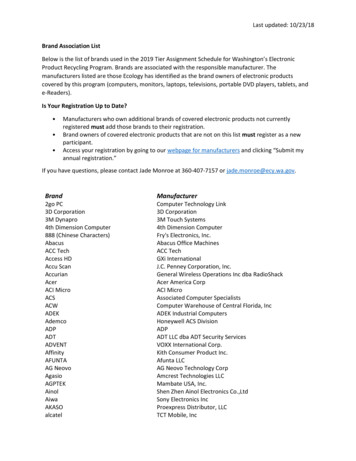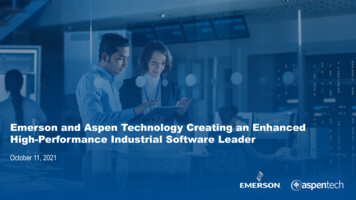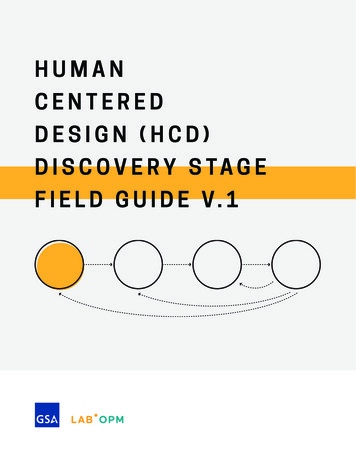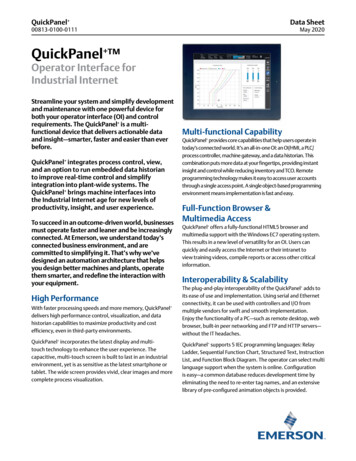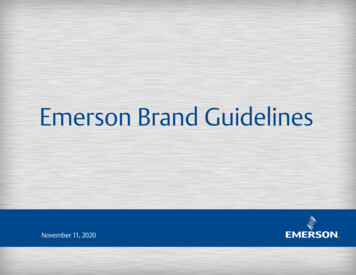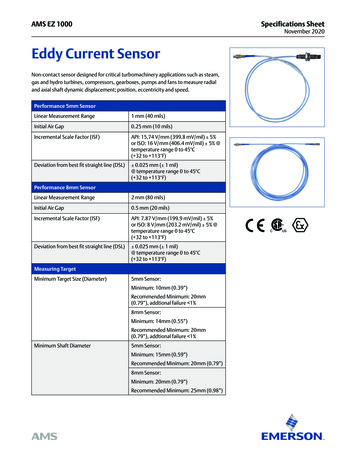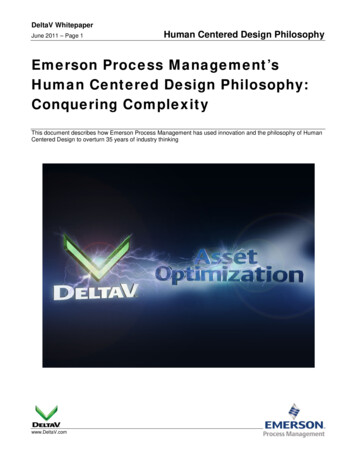
Transcription
DeltaV WhitepaperJune 2011 – Page 1Human Centered Design PhilosophyEmerson Process Management’sHuman Centered Design Philosophy:Conquering ComplexityThis document describes how Emerson Process Management has used innovation and the philosophy of HumanCentered Design to overturn 35 years of industry thinkingwww.DeltaV.com
DeltaV WhitepaperJune 2011 – Page 2Human Centered Design PhilosophyTable of ContentsIntroduction. 3Human Centered Design . 3Complexity Paradox . 4Challenges Solved Using HCD . 4Operator Experience . 4Color Theme Graphics . 5Pattern Recognition . 6Contextual Alarm Knowledge . 7Maintenance Experience . 8AMS Suite . 8Integrated Machinery Protection . 9Easy Asset Performance Management . 10DeltaV S-Series and I/O on Demand. 11S-series Hardware. 11I/O on Demand . 12DeltaV Enclosures . 15Built for Purpose . 16DeltaV Smart Switches. 17DeltaV SIS. 17Summary . 18
DeltaV WhitepaperJune 2011 – Page 3IntroductionHuman Centered DesignIn 2005 Emerson began investing in Human Centered Design based on the trends we were hearing fromcustomers. They were saying they didn't have the people to take advantage of some of the innovations we weredeveloping that would benefit them. So we started thinking differently about how we develop our technology. As aresult we pioneered the concept of Human Centered Design in our industry. We have formally introduced ourHuman Centered Design Institute. Emerson’s focus with Human Centered Design (HCD) is to deliver threeessential benefits: Eliminate Unnecessary Work Reduce the Complexity of Technology Embed Knowledge into TechnologyHuman Centered Design is not just about making products easier to use: it's about products making customers'jobs easier to do. There is an important distinction. As part of the Human Centered Design Institute, Emersonstudied everyday tasks done by people that use our products. This information was used to build a huge library ofroles and responsibility maps.Figure 1 – Example Stakeholder Map with User ProfilesThe library of information provides details about the role – for example: main tasks performed, use of processautomation or other technologies, use of tools or other equipment, and area(s) of the plant where work is done.
DeltaV WhitepaperJune 2011 – Page 4Complexity ParadoxWith HCD in mind, Emerson studied the challenges process industries are facing. Global pressures, regulatory(including health and safety), environmental are long-standing issues in our industry. However, technical peopleskills issues are emerging as critical to being able to operate safely and efficiently.There is a geographic paradox due to a shift in the labor force; while plants are becoming more complex, the newwork force has less experience. Plants are scaling larger and larger and expanding to new locations, singlefacilities are becoming more efficient, integrated complexes –this way one process area feeds directly to anotheron the same site rather than transporting fuel or feedstock to another location- and process automationtechnology is accelerating. At the same time, much of the workforce at the original North American facilities isretiring, while there is a lack of experience in developing areas where new plants are located. The result of all thisis a knowledge and experience void.In addition to this, the total number of staff is being or has been reduced, increasing the amount of responsibilityon every employee.Computing power availability throughout the process automation system and field devices provides flexibility withcontrol strategies. However, it can add complexity when there is a lack of user experience and knowledge.Our investment in Human Centered Design is enabling our users to reach their goals of safety, reliability andefficiency. We do that by understanding the barriers and challenges that keep them from meeting their goals. Weare pointing our technologies at those challenges to make it easier for our users to be successful. First we areeliminating work. Whenever possible, the most important thing we can do to help users is to engineer the work outof the process. As a next step, for the work that remains we are removing the complexity, making it as simple aspossible. Finally, embedding knowledge of those experienced workers that are leaving or who were never there:we are working to institutionalize the specialized knowledge so that even less experienced staff can become moreeffective sooner.Challenges Solved Using HCDThe development of DeltaV version 11 was based on using Human Centered Design to address concerns that arefacing process industries today. Changes have been designed around the user, instead of the user having tochange and adapt to new technologies. Initial system installation, expansions, operations and maintenance haveall been viewed from an HCD perspective.Operator ExperienceOperator roles are expanding – both with an increase in the process area he/she is responsible for, as well as anincrease in the amount of data that is presented. Operators are more effective when they do not miss importantinformation/alarms and when they have the right knowledge at the right time. A combination of the right displaycolors, pattern recognition and knowledge management have been added to DeltaV version 11 to reduceoperator errors and embed knowledge in the system.Much of the research used for optimizing the operator experience was gained by working with the Center forOperator Performance. The Center for Operator Performance is an alliance of academic and process companiesto increase the research specific to the Process Control Industry.
DeltaV WhitepaperJune 2011 – Page 5Figure 2 – Center for Operator Performance Membership Types, Duties and MembersColor Theme GraphicsAfter investigating the best colors to use for operator displays, there is not one right answer. However, in general,research has found lighter display backgrounds to be better than dark (unless the control room is dim, in thatcase, dark is better) and that the use of bright colors should be minimized.In version 11 of DeltaV, there are themes that take these findings into consideration and make it easy forimplementation. There are four “out-of-the-box” HCD themes for operator displays. The themes are Silver, Tan,Light Blue and Dark Blue (for dim control rooms) – named according to the background colors.
DeltaV WhitepaperJune 2011 – Page 6Figure 3 – Example of HCD Silver Theme DisplayThe alarm colors are the same for each theme, but the pipes, tanks, etc. are in the same color family as thebackground. Contrasting colors are used for text and abnormal situations. The themes are based on the globalcolor tables, so the colors are easily modified for specific situations.Pattern RecognitionTypical operator displays use numbers for operators to read and compare process values – Are the valuesdeviating from setpoint? Are they in range? Are they near an alarm limit? Comparing numbers takes focus andmakes it difficult for operators to simply scan a display. Using shapes or patterns to graphically view the dataenables operators to easily scan the process values without having to read and analyze all of the values.Figure 4 – Examples of Pattern Recognition for Process Values
DeltaV WhitepaperJune 2011 – Page 7Having bar graphs or other shapes clearly define where the values is in relation to setpoint, alarm limits, etc. isalso very useful for new operators, support staff and others that are not immediately familiar with the processarea. Pattern recognition is also used to make alarm presentation and important status information (such ason/off, open/closed, abnormal, simulation mode, bad I/O, etc.) obvious and consistent.Figure 5 – Examples of Abnormal Situation PresentationsContextual Alarm KnowledgeHuman Centered Design operator displays make it easier for operators to identify abnormal situations, but oncethey are identified, will the operator know what to do? Again, we are looking at a workforce with less experienceand more responsibility. By embedding knowledge into an alarm or other abnormal situation, a more experienced(and authorized) operator is empowered to modify the alarm help at the operator station, in order to help lessexperienced personnel.The alarm properties in DeltaV are designed for an ISA-18.2 compliant alarm database. Alarm properties includefunctional classification, recommended action, time to respond, probable cause and consequence of inaction.This provides best-in-class rationalization for the operator.Figure 6 – Contextual Alarm Help
DeltaV WhitepaperJune 2011 – Page 8Maintenance ExperiencePlant personnel, such as the Plant Manager, Instrument and Electrical Engineer, Maintenance Manager and theReliability Engineer know that improving a facility's availability and performance, key to achieving businessresults, are dependent on managing production assets. The human centered design concept is aimed atidentifying the information most needed by plant personnel and getting to them in an easy-to-use format. The goalis to make technologies that aren't just reliable, compatible and cost-effective; they can also improve usability andincrease productivity so users see a real impact on business results.Human centered designers worked with marketing and technology people to create prototypes screens that wereintroduced to customers. Through usability testing, we evaluate the product and determine which designs weremost helpful to users in completing common maintenance tasks easily and in minimum time.AMS SuiteThe first Human Centered Design project was the development of the new dashboard structure within AMS Suite.These intuitively designed interfaces known as Device Dashboards for AMS Suite software present workers withan instant view of the critical items they need to evalute, diagnose, and configure each device. Expert guidance isalso provided to streamline the most important and frequently performance tasks by plant operations,maintenance, engineering and maintenance personnel.Before HCD the Asset Management screens in AMS Device Manager were designed to display information, butnot in a way that made clear sense to the users of the software. There were many redundant terms and acronymsthat were not always very intuitive to read and comprehend. There hadn’t been much thought to whereinformation was put on the screen and sometimes the layout of information and graphics could be cluttered. Thedashboards have common tasks front and center, with wizards to aid infrequent or inexperienced users. Users donot have to search around for information being in a different tab or format for different devicesBuilt-in Dashboards.Figure 7 – AMS Device Manager Device Dashboard
DeltaV WhitepaperJune 2011 – Page 9The dashboards are available for over 50 different devices and built around user tasks – with all devices havingthe same layout. Regardless of device type or protocol (PROFIBUS DP, Fieldbus, HART, WirelessHART), youget the exact same look and feel.Figure 8 – Dashboard Examples of Different ProtocolsDrives IntegrationWith the addition of PROFIBUS DP device configuration and diagnostics in AMS Device Manager, there isparticular benefit with drives and motor starters. Diagnostic information from these plant assets is valuable, butpreviously tedious to acquire. Previously, to get diagnostics into a control system required either hard-wired orserial connections. For either option, additional work is required in engineering, drawings and configuration uponinstallation, as well as for any changes that are needed after installation. With AMS Device Manager and DeltaV,PROFIBUS DP drives and starters are simply part of the system. To prevent abnormal situations, diagnostics canbe easily integrated into control strategies, just like any other tag in the system. Alarms and alerts will be sent tooperator stations for enhanced troubleshooting capabilities for AMS Device Manager users.Integrated Machinery ProtectionNearly half of equipment breakdowns are related to poor operating practices, because operators lack feedback onthe effect of operations on machinery health. Turbomachinery and mechanical equipment breakdowns are costlyin both equipment repair and lost production. Therefore, providing operators with visibility of the performance ofthese critical assets, they can make process adjustments and reduce process disruptions.Previously, to provide operators with this information, more than 30 setup and configuration steps were requiredfor each parameter that you wanted to bring into the control system. So, even bringing over 4 out of 24 possibleparameters would require 120 steps. Integration with machinery health diagnostics would take days. Often, plantsdo not have the time or staff to complete the integration, leaving plant operators without key machinery healthdiagnostics, including overall vibration levels, thrust position, and eccentricity value.
DeltaV WhitepaperJune 2011 – Page 10 With DeltaV, AMS Machinery Manager, and the CSI 6500 Machinery Health Monitor, users will have IntegratedMachinery Protection and Prediction within minutes. The complex, expensive, time consuming task of bringingmachinery diagnostics into the process automation system is gone. Users have out-of-the-box machinery healthdiagnostics, complete with pre-configured graphical elements to present the data at the operator workstation.Adding machinery health information to the DeltaV Process Automation System takes three easy steps: From AMS Machinery Manager, initiate scanning of the CSI 6500 for available properties, parameters andalarms. Select the parameters and alarms that are relevant, and enter the DeltaV Controller and Area names. A configuration (.fhx) file is created and imported into DeltaV. Control modules and function blocks areautomatically built during the import.Through the AMS Suite, the turbomachinery diagnostic information is also easily accessible to maintenance andreliability engineers and managers. These plant personnel can analyze data from machines along with other plantassets to prioritize maintenance and repair activities to mitigate risk and optimize maintenance costs.With Emerson, machinery health data is easy to access and present to plant personnel. The turbomachineryinformation that is available enables users to avoid catastrophic failures, reduce maintenance costs and maximizeproduction. For more information on easily integrating machinery diagnostics into DeltaV, please refer to theIntegrated Machinery Protection and Prediction with Process Automation whitepaperEasy Asset Performance ManagementEmerson has reduced the complexity of the plant environment through tools that help plant management makebetter business decisions. AMS Suite Asset Performance Management, based on Meridium's APM software,combines predictive intelligence with asset reliability information and decision support for smarter businessdecisions. It adds real-time analytics and reporting that enable new levels of insight into asset performance forcontinuous improvement.AMS Suite now streamlines the identification of bad actors, eliminates repetitive tasks, and highlightsopportunities for new operating practices. Maintenance and reliability mangers receive more integrated, real-timeinformation to determine that maintenance dollars are being spent in the most critical areas for the greatestbusiness return.
DeltaV WhitepaperJune 2011 – Page 11Figure 9 – One Dashboard for Plant InformationDeltaV S-Series and I/O on DemandS-series HardwareThe new DeltaV S-series hardware is an evolution of the proven M-series hardware. The new design deliversinstallation and robustness enhancements, while still using the same proven technologies field tested over the lastdecade. The S-series hardware has been re-designed with a heat dissipation technology that allows for acompletely enclosed shell (no vents). This prevents particles from entering the cards and short-circuitingelectronics. “Easy-on-Hard-off” technology with the S-series means there are no screws needed when installingthe cards onto the backplane, yet to get them off takes a manual action by pushing a button on top of the card.
DeltaV WhitepaperJune 2011 – Page 12Figure 10 – DeltaV S-series HardwareI/O on DemandFor several years, the DeltaV Process Automation has had the capability to communicate with different types offield devices – HART, FOUNDATION Fieldbus, traditional analog and discrete, DeviceNet , PROFIBUS DP, andAS-i bus. More recently, communication with wireless devices has added another option. This has made itpossible for DeltaV users to select the appropriate technology for the application, budget and user preference.With the release of version 11, there is an additional option for connecting field devices to DeltaV, calledElectronic Marshalling, which will significantly reduce installation time and money. I/O on Demand incorporates allof the options for field devices connections to DeltaV, enabling users to have what type of I/O they want, whenthey want it, where ever they want it, or, more simply—I/O of any type, anytime, anywhere.Figure 11 – DeltaV I/O on DemandWith I/O on Demand, a project can bring the I/O into the control system in one of four distinct ways, selecting thebest, most cost effective approach in each case.
DeltaV WhitepaperJune 2011 – Page 13WirelessThe use of wireless devices networks results in less upfront cabinet design and engineering, lower installationcosts, smaller footprint for the process automation system. And there are numerous examples of users takingadvantage of these benefits to implementing wireless device networks. However, there have been some caseswhere wireless didn’t work because of either environmental classification or lack of redundancy. DeltaV improveson its wireless capabilities and addresses these issues in version 11, by providing a redundant gateway and awireless link for Zone 1 environments.Implementing wireless devices networks with DeltaV will now be done through a Wireless I/O Card (WIOC) and aSmart Wireless Remote Link. This new architecture provides increased availability with full redundancy. TheWIOC sits on the DeltaV network, as a redundant pair, with redundant communications and a redundant poweroption. The redundant Smart Wireless Remote Links are installed in the plant, as close to the devices as possible.The remote links then connect to the WIOC with redundant power and communications.Figure 12 – Wireless Network with Redundant WIOCs and CommunicationFOUNDATION FieldbusFOUNDATION Fieldbus has also provided many benefits to sites that have implemented it. One of the ‘stickingpoints’ with installing Fieldbus is the physical layer, where the work process involved: Power supplies sized, power distribution engineered Power conditioning designed, redundant Cabinets designed/constructed to support equipment For troubleshooting complex scopes are used or third party diagnostics are connectedThe H1 Interface Card in version 11 has Fieldbus power and diagnostic integrated right into the card. Thiseliminates all the work, equipment, cost and complexity involved with the items listed above. In a large Fieldbusinstallation, there were about 2,500 segments that required about 5,000 power conditioners. Those powerconditioners alone required 32 cabinets. So the engineering, fabrication, shipment, and footprint of the cabinetsfor the power conditioners would be eliminated, in addition to all of the equipment costs.
DeltaV WhitepaperJune 2011 – Page 14Figure 13 – Fieldbus Work Eliminated by H1 Cards with Integrated PowerElectronic MarshallingThe newest option with I/O on Demand is called Electronic Marshalling, where traditional cross-marshalling offield wires is eliminated. Traditionally, to connect a field device to a process automation system, wires from ahome run cable would be landed on terminal strips, and then cross-wired to the appropriate I/O card. This hasbeen a ‘necessary evil’ – a low-value, pain-staking task that became much worse with any I/O changes ormistakes made with wiring.The better way – with Human Centered Design – eliminates tedious tasks and is flexible to allow for easyadjustments when changes to I/O are made. Just as with traditional wiring, home run wires are landed in amarshalling cabinet. However, with Electronic Marshalling, a Characterization Module (CHARM) is plugged into aterminal block to characterize the signal and send it to any controller in the DeltaV System. Changes to I/O typeare easily made by replacing the CHARM type.An extensive amount of work – from cabinet design to wiring diagrams – is eliminated with Electronic Marshalling,compared with traditional wiring. The overall system footprint is also significantly reduced with ElectronicMarshalling, because eliminating cross-wiring reduces the number of cabinets needed.
DeltaV WhitepaperJune 2011 – Page 15Figure 14 – Comparison of Traditional Wired Marshalling with Electronic MarshallingFor more information and details on Electronic Marshalling, please see the following whitepapers: ElectronicMarshalling Overview, Electronic Marshalling Performance, Electronic Marshalling Robustness and I/O onDemand Cost Study.DeltaV EnclosuresFor Greenfield projects or Brownfield expansions, Emerson can now provide cost savings and lower project riskwith off-the-shelf DeltaV Enclosures for system hardware. There are three options for DeltaV Enclosures: Factory Certified Enclosures Configure-to-Order Enclosures Design-to-Order EnclosuresFactory Certified Enclosures are either ‘I/O room’ cabinets or field junction boxes that are pre-designed ElectronicMarshalling enclosures, with a very limited number of options. For example, the I/O room cabinets can be eitherfront access or front and rear access. Either way, each side comes with three rows of CHARM base plates. Thereis neither upfront design/engineering required for these enclosures nor is it necessary to run an acceptance testupon shipment. Factory Certified Enclosures are ready for use, just as a DeltaV Controller is ready for use uponshipment, and they provide significant cost savings over enclosures designed from scratch.Configure-to-Order Enclosures have a little more flexibility, with a given palate of components from which tochoose. Examples of components available for selection are power supplies, network switches, DeltaV controllersand I/O cards. The selected components are then input into an engineering software tool that provides theenclosure layout. The enclosure design is more of a selection process, so upfront engineering costs are veryminimal, and Configure-to-Order Enclosures also provide considerable cost savings.
DeltaV WhitepaperJune 2011 – Page 16Design-to-Order Enclosures have the most flexibility. These enclosures are fully customized to the project-specificneeds. Project engineers will go through the full upfront design, specification and engineering process for theseenclosures.All enclosures will use best cost manufacturing practices from Emerson, follow DeltaV installation best practices,and will include full documentation. A project may not be limited to one enclosure type, and two or more enclosuretypes may be needed to meet project requirements. Project timeline, budget and system components should betaken into consideration when ordering enclosures. The figure below illustrates options with enclosurecomponents and design, and how there is an increase in amount of testing, cost and time.Figure 15 – Comparison of Investment in Time, Cost and Testing for EnclosuresFor more details on DeltaV Enclosures, please see the DeltaV Enclosures whitepaper.Built for PurposeOver the last ten years, commercial off-the-shelf technologies (COTS) have provided tremendous increases infunctionality and cost advantages to end-users of today’s automation systems. The DeltaV system was the firstsuch system on the market, and continues to provide open, proven products to its process manufacturers.However, while COTS has given many advantages, it has also come with expensive administration and life-cyclecosts requirements. A better approach is to take advantage of the cost benefits and open standards of COTS, butthen add functionality that allows the equipment to function much more like other parts of the system (plug-andplay, full lifecycle support without upgrades, built-in security, etc.). We call this balance “Built for Purpose”, andthe DeltaV system is the first automation system to address this critical need in many of the most important facetsof the system.
DeltaV WhitepaperJune 2011 – Page 17DeltaV Smart SwitchesBuilt for Purpose can be seen with the recently introduced Smart Switches – network switches specifically for usewith DeltaV. Having these switches gives process control engineers and technicians direct access to the networkfor installation, setup and maintenance. Smart Switches eliminate the need for IT personnel help with networksetup, because all of the setup is done through DeltaV. The network setup includes the ability to secure thenetwork by easily locking out unused ports, but giving the ability to still easily re-enable the ports when needed.While the setup and security for network switches has been fully integrated into DeltaV, so have diagnostics. Witha third party switch, there is no indication on a DeltaV workstation to alert personnel of a problem or pendingproblem. With Smart Switches, PlantWeb Alerts will be generated and sent to the operator and maintenanceconsoles if there is a port or other hardware failure, communication error or if someone tries to access a lockeddown network. This gives process automation personnel the information they need to quickly fix any problem.For more information and details on DeltaV Smart Switches, please see the Smart Switches Product Data Sheet.DeltaV SIS Emerson has extended its digital PlantWeb architecture to safety systems with Smart SIS, which provides newvalue to customers by making plants safer, enabling regulatory compliance, increasing reliability and loweringlifecycle costs. With on-board computing power, intelligent field devices have become an integral part of theSafety Instrumented System and made systems safer because device health is known. DeltaV SIS provides aseparate safety system, with common operations, maintenance and engineering platforms. This lowersinstallation and lifecycle costs because DeltaV SIS eliminates mapping of tags between the basic process controlsystem and the safety system, OPC or serial links, and the use of additional engineering tools.With version 11, DeltaV SIS has the ability to handle large projects with the introduction of SISNet Domains. Thelimits with SIS are now based on the DeltaV System limits. One system can have 30,000 DSTs – with a maximumof 15 SISNet Rings, each of which can have as many as 100 nodes. The rings can remain completelyindependent of each other, or they can be connected together via a redundant Ethernet bridge for globalcommunications between rings. SISNet Domains further increase design flexibility, provide improved support forlarge projects, easier expansion of existing systems, and easier isolation of separate SIS applications.Figure 16 – SISNet Domains
DeltaV WhitepaperJune 2011 – Page 18For more information and details on SISNet Domains, please see the DeltaV SIS – Large Systems whitepaper.SummaryEmerson strives to develop new technologies that focus on making tasks easier to accomplish, less complex andthat adapt to the human using the technology, instead of the other way around. The benefits that can be seen inthe version 11 release of DeltaV due to HCD include: Operators more focused and productive based on industry standard “color scale” graphics Cost savings on graphic implementation due to “out-of-the-box” co
Human Centered Design is not just about making products easier to use: it's about products making customers' jobs easier to do. There is an important distinction. As part of the Human Centered Design Institute, Emerson studied everyday tasks done by people that use our products. This information was used to build a huge library of
